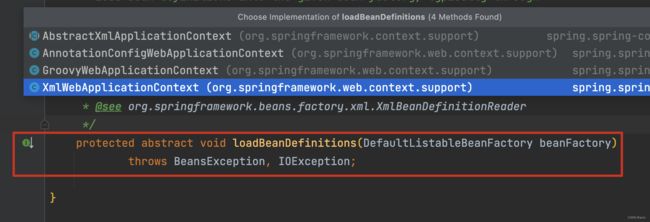【源码解析】Spring源码解读-bean的加载
Spring的整体流程其实就是通过配置 xml、注解将自定义bean类信息进行配置,然后通过BeanDefinitionReader读取配置信息,由Dom转换成xml解析成Docment。在通过加载的配置信息进行初始化Bean对象,然后在对象的前后进行处理,也就是不同的处理器,AOP、自动装配、事务等其实都是这个原理。而我们的IOC容器本质其实就是一个Map对象。
spring-bean最核心的两个类:DefaultListableBeanFactory和XmlBeanDefinitionReader
DefaultListableBeanFactory
- AliasRegistry:定义对alias的简单增删改等操作
- SimpleAliasRegistry:主要使用map作为alias的缓存,并对接口AliasRegistry进行实现
- SingletonBeanRegistry:定义对单例的注册及获取
- BeanFactory:定义获取bean及bean的各种属性
- DefaultSingletonBeanRegistry:默认对接口SingletonBeanRegistry各函数的实现
- HierarchicalBeanFactory:继承BeanFactory,也就是在BeanFactory定义的功能的基础上增加了对parentFactory的支持
- BeanDefinitionRegistry:定义对BeanDefinition的各种增删改操作
- FactoryBeanRegistrySupport:在DefaultSingletonBeanRegistry基础上增加了对FactoryBean的特殊处理功能
- ConfigurableBeanFactory:提供配置Factory的各种方法
- ListableBeanFactory:根据各种条件获取bean的配置清单
- AbstractBeanFactory:综合FactoryBeanRegistrySupport和ConfigurationBeanFactory的功能
- AutowireCapableBeanFactory:提供创建bean、自动注入、初始化以及应用bean的后处理器
- AbstractAutowireCapableBeanFactory:综合AbstractBeanFactory并对接口AutowireCapableBeanFactory进行实现
- ConfigurableListableBeanFactory:BeanFactory配置清单,指定忽略类型及接口等
- DefaultListableBeanFactory:综合上面所有功能,主要是对Bean注册后的处理
XmlBeanFactory对DefaultListableBeanFactory类进行了扩展,主要用于从XML文档中读取BeanDefinition,对于注册及获取Bean都是使用从父类DefaultListableBeanFactory继承的方法去实现,而唯独与父类不同的个性化实现就是增加了XmlBeanDefinitionReader类型的reader属性。在XmlBeanFactory中主要使用reader属性对资源文件进行读取和注册
XmlBeanDefinitionReader

XML配置文件的读取是Spring中重要的功能,因为Spring的大部分功能都是以配置作为切入点的,可以从XmlBeanDefinitionReader中梳理一下资源文件读取、解析及注册的大致脉络,首先看看各个类的功能
ResourceLoader:定义资源加载器,主要应用于根据给定的资源文件地址返回对应的Resource
BeanDefinitionReader:主要定义资源文件读取并转换为BeanDefinition的各个功能
EnvironmentCapable:定义获取Environment方法
DocumentLoader:定义从资源文件加载到转换为Document的功能
AbstractBeanDefinitionReader:对EnvironmentCapable、BeanDefinitionReader类定义的功能进行实现
BeanDefinitionDocumentReader:定义读取Document并注册BeanDefinition功能
BeanDefinitionParserDelegate:定义解析Element的各种方法
ClassPathXmlApplicationContext
因为我们是使用XML进行加载启动的。
ClassPathXmlApplicationContext classPathXmlApplicationContext = new ClassPathXmlApplicationContext("beans.xml");
ServiceA beanServiceA = classPathXmlApplicationContext.getBean(ServiceA.class);
启动的时候会刷新容器
public ClassPathXmlApplicationContext(
String[] configLocations, boolean refresh, @Nullable ApplicationContext parent)
throws BeansException {
super(parent);
setConfigLocations(configLocations);
if (refresh) {
refresh(); //刷新容器
}
}
而这个刷新方法其实是比较核心的方法
public void refresh() throws BeansException, IllegalStateException {
synchronized (this.startupShutdownMonitor) {
StartupStep contextRefresh = this.applicationStartup.start("spring.context.refresh");
//准备上下文环境 Prepare this context for refreshing.
prepareRefresh();
// Tell the subclass to refresh the internal bean factory.
// 工厂创建:BeanFactory第一次开始创建的时候,有xml解析逻辑。
ConfigurableListableBeanFactory beanFactory = obtainFreshBeanFactory();
//给容器中注册了环境信息作为单实例Bean方便后续自动装配;放了一些后置处理器处理(监听、xxAware功能) Prepare the bean factory for use in this context.
prepareBeanFactory(beanFactory);
try {
//留给子类的模板方法,允许子类继续对工厂执行一些处理; Allows post-processing of the bean factory in context subclasses.
postProcessBeanFactory(beanFactory);
StartupStep beanPostProcess = this.applicationStartup.start("spring.context.beans.post-process");
//【大核心】工厂增强:执行所有的BeanFactory后置增强器;利用BeanFactory后置增强器对工厂进行修改或者增强,配置类会在这里进行解析。 Invoke factory processors registered as beans in the context.
invokeBeanFactoryPostProcessors(beanFactory);
//【核心】注册所有的Bean的后置处理器 Register bean processors that intercept bean creation.
registerBeanPostProcessors(beanFactory);
beanPostProcess.end();
//初始化国际化功能 Initialize message source for this context.
initMessageSource();
//初始化事件多播功能(事件派发) Initialize event multicaster for this context.
initApplicationEventMulticaster();
// Initialize other special beans in specific context subclasses.
onRefresh();
//注册监听器,从容器中获取所有的ApplicationListener; Check for listener beans and register them.
registerListeners();
// Instantiate all remaining (non-lazy-init) singletons.
//【大核心】bean创建;完成 BeanFactory 初始化。(工厂里面所有的组件都好了)
finishBeanFactoryInitialization(beanFactory);
//发布事件 Last step: publish corresponding event.
finishRefresh();
}
catch (BeansException ex) {
if (logger.isWarnEnabled()) {
logger.warn("Exception encountered during context initialization - " +
"cancelling refresh attempt: " + ex);
}
// Destroy already created singletons to avoid dangling resources.
destroyBeans();
// Reset 'active' flag.
cancelRefresh(ex);
// Propagate exception to caller.
throw ex;
}
finally {
// Reset common introspection caches in Spring's core, since we
// might not ever need metadata for singleton beans anymore...
resetCommonCaches();
contextRefresh.end();
}
}
}
protected final void refreshBeanFactory() throws BeansException {
if (hasBeanFactory()) {
destroyBeans();
closeBeanFactory();
}
try {
DefaultListableBeanFactory beanFactory = createBeanFactory(); //创建保存所有Bean定义信息的档案馆
beanFactory.setSerializationId(getId());
customizeBeanFactory(beanFactory);
loadBeanDefinitions(beanFactory);
this.beanFactory = beanFactory;
}
catch (IOException ex) {
throw new ApplicationContextException("I/O error parsing bean definition source for " + getDisplayName(), ex);
}
}
protected DefaultListableBeanFactory createBeanFactory() {
return new DefaultListableBeanFactory(getInternalParentBeanFactory()); //创建档案馆
}

因为是通过XML配置的,所以就使用XMLWebApplicationContext
protected void loadBeanDefinitions(DefaultListableBeanFactory beanFactory) throws BeansException, IOException {
// Create a new XmlBeanDefinitionReader for the given BeanFactory.
//XML读取器
XmlBeanDefinitionReader beanDefinitionReader = new XmlBeanDefinitionReader(beanFactory);
// Configure the bean definition reader with this context's
// resource loading environment.
beanDefinitionReader.setEnvironment(getEnvironment());
beanDefinitionReader.setResourceLoader(this);
beanDefinitionReader.setEntityResolver(new ResourceEntityResolver(this));
// Allow a subclass to provide custom initialization of the reader,
// then proceed with actually loading the bean definitions.
initBeanDefinitionReader(beanDefinitionReader);
loadBeanDefinitions(beanDefinitionReader);
}
解析以及注册BeanDefinitions
public int loadBeanDefinitions(EncodedResource encodedResource) throws BeanDefinitionStoreException {
Assert.notNull(encodedResource, "EncodedResource must not be null");
if (logger.isTraceEnabled()) {
logger.trace("Loading XML bean definitions from " + encodedResource);
}
Set<EncodedResource> currentResources = this.resourcesCurrentlyBeingLoaded.get();
if (!currentResources.add(encodedResource)) {
throw new BeanDefinitionStoreException(
"Detected cyclic loading of " + encodedResource + " - check your import definitions!");
}
try (InputStream inputStream = encodedResource.getResource().getInputStream()) {
InputSource inputSource = new InputSource(inputStream);
if (encodedResource.getEncoding() != null) {
inputSource.setEncoding(encodedResource.getEncoding());
}
return doLoadBeanDefinitions(inputSource, encodedResource.getResource()); //这里是重点
}
catch (IOException ex) {
throw new BeanDefinitionStoreException(
"IOException parsing XML document from " + encodedResource.getResource(), ex);
}
finally {
currentResources.remove(encodedResource);
if (currentResources.isEmpty()) {
this.resourcesCurrentlyBeingLoaded.remove();
}
}
}
protected int doLoadBeanDefinitions(InputSource inputSource, Resource resource)
throws BeanDefinitionStoreException {
try {
Document doc = doLoadDocument(inputSource, resource); //利用dom解析工具把xml变成Document
int count = registerBeanDefinitions(doc, resource); //根据document信息注册bean信息
if (logger.isDebugEnabled()) {
logger.debug("Loaded " + count + " bean definitions from " + resource);
}
return count;
}
}
这里主要就是验证XML文件 调用loadDocument根据xml文件获取Document实例,调用registerBeanDefinitions 注册Bean实例。具体的XML转换成Docuemnt流程这里不细说。
protected Document doLoadDocument(InputSource inputSource, Resource resource) throws Exception {
return this.documentLoader.loadDocument(inputSource, getEntityResolver(), this.errorHandler,
getValidationModeForResource(resource), isNamespaceAware());
}
解析及注册BeanDefinitions
上面是进行加载xml文件转换成Document对象后,就调用了registerBeanDefinitions方法。
public int registerBeanDefinitions(Document doc, Resource resource) throws BeanDefinitionStoreException {
BeanDefinitionDocumentReader documentReader = createBeanDefinitionDocumentReader();
int countBefore = getRegistry().getBeanDefinitionCount();
documentReader.registerBeanDefinitions(doc, createReaderContext(resource));
return getRegistry().getBeanDefinitionCount() - countBefore;
}
BeanDefinitionDocumentReader是一个接口,具体实现其实是DefaultBeanDefinitionDocumentReader,createBeanDefinitionDocumentReader是利用工具实现 DefaultBeanDefinitionDocumentReader,而这里显然使用的是接口表达。也就是面向接口编程。
protected BeanDefinitionDocumentReader createBeanDefinitionDocumentReader() {
return BeanUtils.instantiateClass(this.documentReaderClass);
}
public void registerBeanDefinitions(Document doc, XmlReaderContext readerContext) {
this.readerContext = readerContext;
doRegisterBeanDefinitions(doc.getDocumentElement());
}
解析逻辑的核心方法doRegisterBeanDefinitions
protected void doRegisterBeanDefinitions(Element root) {
// Any nested elements will cause recursion in this method. In
// order to propagate and preserve default-* attributes correctly,
// keep track of the current (parent) delegate, which may be null. Create
// the new (child) delegate with a reference to the parent for fallback purposes,
// then ultimately reset this.delegate back to its original (parent) reference.
// this behavior emulates a stack of delegates without actually necessitating one.
BeanDefinitionParserDelegate parent = this.delegate;
this.delegate = createDelegate(getReaderContext(), root, parent);
if (this.delegate.isDefaultNamespace(root)) {
String profileSpec = root.getAttribute(PROFILE_ATTRIBUTE);
if (StringUtils.hasText(profileSpec)) {
String[] specifiedProfiles = StringUtils.tokenizeToStringArray(
profileSpec, BeanDefinitionParserDelegate.MULTI_VALUE_ATTRIBUTE_DELIMITERS);
// We cannot use Profiles.of(...) since profile expressions are not supported
// in XML config. See SPR-12458 for details.
if (!getReaderContext().getEnvironment().acceptsProfiles(specifiedProfiles)) {
if (logger.isDebugEnabled()) {
logger.debug("Skipped XML bean definition file due to specified profiles [" + profileSpec +
"] not matching: " + getReaderContext().getResource());
}
return;
}
}
}
preProcessXml(root);
parseBeanDefinitions(root, this.delegate);
postProcessXml(root);
this.delegate = parent;
}
最终解析动作落地在两个方法处:parseDefaultElement(ele, delegate) 和 delegate.parseCustomElement(root)。我们知道在 Spring 有两种 Bean 声明方式:
配置文件式声明:
自定义注解方式:tx:annotation-driven
protected void parseBeanDefinitions(Element root, BeanDefinitionParserDelegate delegate) {
if (delegate.isDefaultNamespace(root)) {
NodeList nl = root.getChildNodes();
for (int i = 0; i < nl.getLength(); i++) {
Node node = nl.item(i);
if (node instanceof Element) {
Element ele = (Element) node;
if (delegate.isDefaultNamespace(ele)) { //遍历文档中的所有节点
parseDefaultElement(ele, delegate);
}
else {
delegate.parseCustomElement(ele);
}
}
}
}
else {
delegate.parseCustomElement(root);
}
}
至此,整个bean加载的过程就完毕了,但是后续其实还有对bean的初始化、实例化以及AOP、事务等流程。
小结
本篇其实主要就是从bean是如何加载xml文件生成 解析及注册BeanDefinitions过程。后续我们会接着介绍Bean的生命周期、初始化、AOP、MVC以及tomcat源码。



